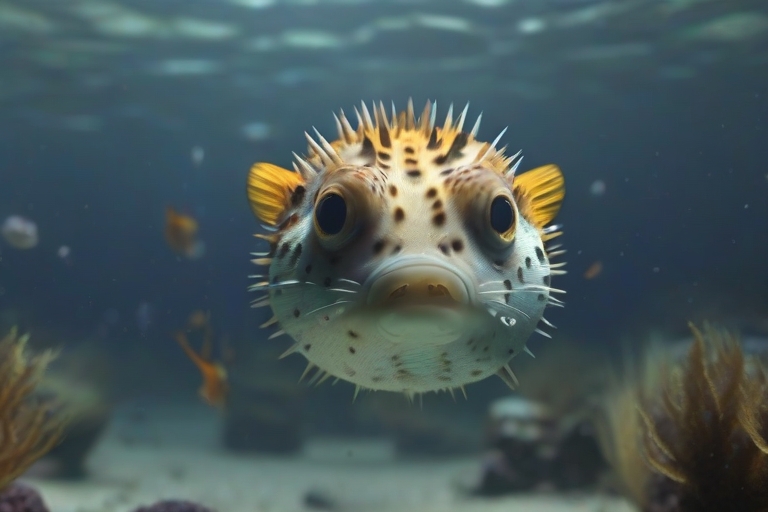Introduction
The underwater realm is teeming with captivating creatures, each boasting unique features and adaptations. Among the most intriguing inhabitants of our oceans and rivers are the members of the Tetraodontidae family, commonly known as Pufferfish. With over 120 species distributed across both saltwater and freshwater environments in tropical and subtropical regions, these enchanting beings have captured the attention of marine enthusiasts and scientists alike.
 |
| Pufferfish |
Species Diversity
The Tetraodontidae family encompasses a wide array of Pufferfish species, each with its own distinctive characteristics. From the iconic Fugu in Japan to the delightful Dog-faced Puffer, these aquatic wonders showcase nature’s creativity in form and function. While some prefer the warm embrace of tropical waters, others thrive in the diverse ecosystems of freshwater habitats.
Habitat Preferences
Pufferfish are adaptable beings, displaying a remarkable ability to inhabit various aquatic environments. From the bustling coral reefs of the tropics to the serene freshwater rivers, these creatures have carved out niches for themselves in a range of ecosystems. Their adaptability highlights the resilience of these creatures in the face of changing environmental conditions.
Adaptations for Survival
One of the most remarkable features of Pufferfish is their inflatable and expandable bodies. This unique adaptation serves a dual purpose – a defense mechanism and a tool for communication. When threatened, Pufferfish can rapidly inflate their bodies, transforming into a formidable, spiky ball that discourages potential predators. This ability to puff up acts as a visual deterrent, deterring would-be attackers and providing the Pufferfish with a chance to escape unscathed.
Toxicity and Tetrodotoxin
One of the intriguing aspects of Pufferfish biology is the presence of tetrodotoxin, a potent neurotoxin found in their tissues. While this toxin serves as a formidable defense against predators, it has also given rise to the infamous reputation of certain Pufferfish species, such as the Fugu. Tetrodotoxin can be lethal to humans if ingested, making these creatures a subject of caution and fascination in culinary and scientific circles alike.
Dietary Preferences
Pufferfish are primarily carnivorous, with a diet that includes a variety of marine organisms. From shellfish to small fish, these agile hunters use their beak-like mouths to capture and consume their prey. Despite their predatory nature, Pufferfish play a vital role in maintaining the ecological balance of their habitats by controlling the population of smaller marine organisms.
Aesthetic Appeal
Beyond their biological adaptations, Pufferfish are celebrated for their aesthetic appeal. The intricate patterns and unique shapes displayed by different species add to their charm. Their beady eyes, combined with their endearing expressions, create an underwater spectacle that captivates observers. The ability to change colors and patterns further adds to the mystique of these aquatic wonders.
Life Cycle and Development
The life cycle of Pufferfish is a fascinating journey that unfolds in stages. From the moment the eggs are laid to the development of larvae, the transformation into juveniles, and finally, the maturation into adults, each phase contributes to the intricate web of life in aquatic ecosystems. Understanding the life cycle of Pufferfish is crucial for conservation efforts aimed at preserving their populations and habitats.
Behavioral Patterns
Pufferfish exhibit various behavioral patterns, ranging from solitary to schooling behaviors. While some species prefer the solace of a solitary existence, others form schools for protection and social interaction. Nocturnal feeding is common among Pufferfish, as they take advantage of the cover of darkness to hunt for prey. These behavioral nuances provide valuable insights into the ecological roles played by Pufferfish in their respective habitats.
Aquarium Keeping Challenges
For those fascinated by the allure of Pufferfish, the prospect of keeping them in aquariums presents both rewards and challenges. Their unique requirements, including specialized diets and water conditions, make them a challenging choice for aquarium enthusiasts. However, the effort invested in providing proper care is rewarded with the opportunity to observe these intriguing creatures up close.
Conservation Concerns
While Pufferfish continue to capture the imagination of marine enthusiasts, some species face threats to their existence. Overfishing and habitat loss pose significant challenges to the conservation of certain Pufferfish populations. Recognizing the importance of preserving their natural habitats and implementing sustainable fishing practices is crucial for ensuring the continued well-being of these remarkable aquatic beings.
Conclusion
In the vast tapestry of marine life, Pufferfish stand out as enchanting ambassadors of nature’s ingenuity. From their inflatable bodies to the presence of tetrodotoxin, each facet of their existence sparks curiosity and admiration. As we delve deeper into the intricacies of their biology, behavior, and conservation needs, we uncover a world that beckons us to appreciate and protect these inflatable wonders for generations to come.
